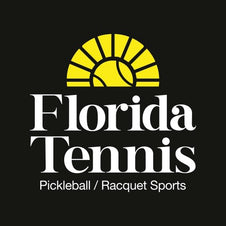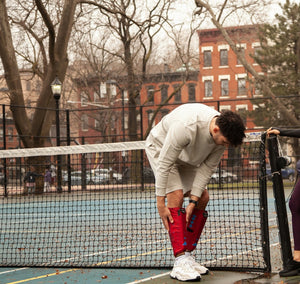Recovery Techniques for Competitive Tennis Players
Aug 24, 2024
In the world of competitive tennis, recovery is as crucial as training. The intense physical demands of the game, combined with the mental pressure, can lead to significant stress on players. Effective recovery techniques not only help mitigate stress but also enhance overall performance, in addition to preventing injuries.

Photo credit: Jamaal Cooks / Unsplash
Some of the key recovery methods used by competitive tennis players to fight stress and optimize their performance include:
Active Recovery – Low impact, low to moderate intensity aerobic exercises to help flush the body of the bi-products of exercise.
Optimal Nutrition - Eating the right foods helps repair muscle tissues, replenish energy stores, and reduce inflammation.
Massage Therapy - Massage therapy helps alleviate muscle soreness, reduce tension, and improve circulation.
Compression Therapy - Compression therapy involves some apparatus (socks/sleeves/boots) to improve circulation, which aids in recovery and a decrease in muscle soreness.
Meditation - Stress management and mental relaxation techniques help players cope with the psychological demands of the game.
Flexibility - Stretching and flexibility exercises help reduce muscle stiffness, improve range of motion, and enhance overall muscle function.

Photo credit: Christian Tenguan / Unsplash.
Sleep and Rest - Quality sleep is fundamental for both physical and mental recovery. During deep REM sleep, the body is able to repair muscle tissue and restore energy levels.
Cold and Hot Therapy - Cold and hot therapy can help manage inflammation, reduce muscle soreness, and enhance recovery.
Breathing Exercises - Breathing exercises help manage stress and promote relaxation by calming the nervous system and reducing muscle tension.
This laundry list of methods may seem novel to the beginner or even intermediate player, but for the accomplished, top seeds, it may be a daily ritual.
Recovery is considered a means of decreasing both the physical and mental stressors of exercise, and returning the body to a state of homeostasis. “Sound Mind–Sound Body” says it all! Let’s take a closer look at what modalities are being used today, to help in restoring this connection to the competitive tennis player.
Magnetherapy is a popular means of decreasing the sympathetic signals (fight or flight) that the body experiences during and even post-activity. At Boca CryoTM we use a device called the MagnesphereTM. This device targets the vagus nerve, which is responsible for the parasympathetic (rest and digest) signal. This, in turn, calms the body and returns it to a level of self-healing and repair. The sixty-minute exposure puts most to sleep, regardless of time of day.
Whole Body Cryotherapy is widely used for decreasing inflammation and pain by exposing the body to extremely cold temperatures for 3 to 3.5 minutes. More importantly, the parasympathetic response to the (fight or flight) sympathetic response to the cold, results in amazingly restful sleep following treatments. At Boca CryoTM we use only cold air to cool the chamber. Most use liquid nitrogen to cool, which can be dangerous if inhaled.

Photo credit: Boca Cryo
Ice baths are also popular but uncomfortable for many and overkill for most. When compared to three minutes of cold air chambers, sitting in an ice bath for extended periods of time, results in the core temperature dropping as opposed to the cold air devices.
Heat Therapy is another form of relaxation therapy which can come in the form of steam or sauna or if local application, to relax tight muscles and improve flexibility.
Alternating between hot and cold can also stimulate blood flow and accelerate recovery. This is referred to as Contrast Therapy.
Breathing Exercises are exercises to help manage stress and promote relaxation by calming the nervous system and reducing muscle tension.
Unless under exhaustive stressors, like vigorous exercise or playing a tennis match, we are all shallow breathers. The body’s need for more oxygen comes only when demand increases. In these cases, our breaths deepen and become more rapid. We can train the body to become more efficient at taking in oxygen and expelling carbon dioxide by the practice of “Deep Breathing”. Learning to use your diaphragm, as well as your lungs, enables you to relax your body and mind. Studies have also shown that breathing through your nose only, can increase air moisture, filter toxins, increases oxygen levels and increase nitric oxide levels.
There are also several techniques for controlling your breathing to reduce anxiety, lower heart rate and relax the body to be able to manage stress levels during critical times of competition. Box breathing (used by military Special Forces) and Wim Hof are two popular examples of these stress-reducing techniques.
Every few months we hold a Breath Work Seminar at Boca CryoTM. We introduce breathing techniques followed by either an ice bath or whole body cryotherapy. After just one session, participants find it easier to deal with the stress of entering a stress-induced atmosphere like extreme cold. Breath work is an amazingly effective way of controlling stress levels!
Conclusion
Effective recovery techniques are essential for competitive tennis players to manage stress, enhance performance, and prevent injuries. By incorporating any or all of the listed methods of recovery, players can better cope with the physical and mental demands of the game. Choosing the recovery strategy that is best for you, can help you stay on top of your game, perform optimally, and enjoy a successful tennis career….Stress Free!
===
Ian Pyka was a two-sport collegiate athlete and three-time All-American who made the Olympic team. Pyka went on to become the strength and conditioning coach at the Florida Panthers and New England Patriots. Pyka currently teaches at FAU's Exercise Science Department and owns Boca Cryo located at 190 Glades Rd., Suite C, in Boca Raton. Visit bocacryo.com to learn more. Top Photo: Michael DeMoya / Unsplash.

